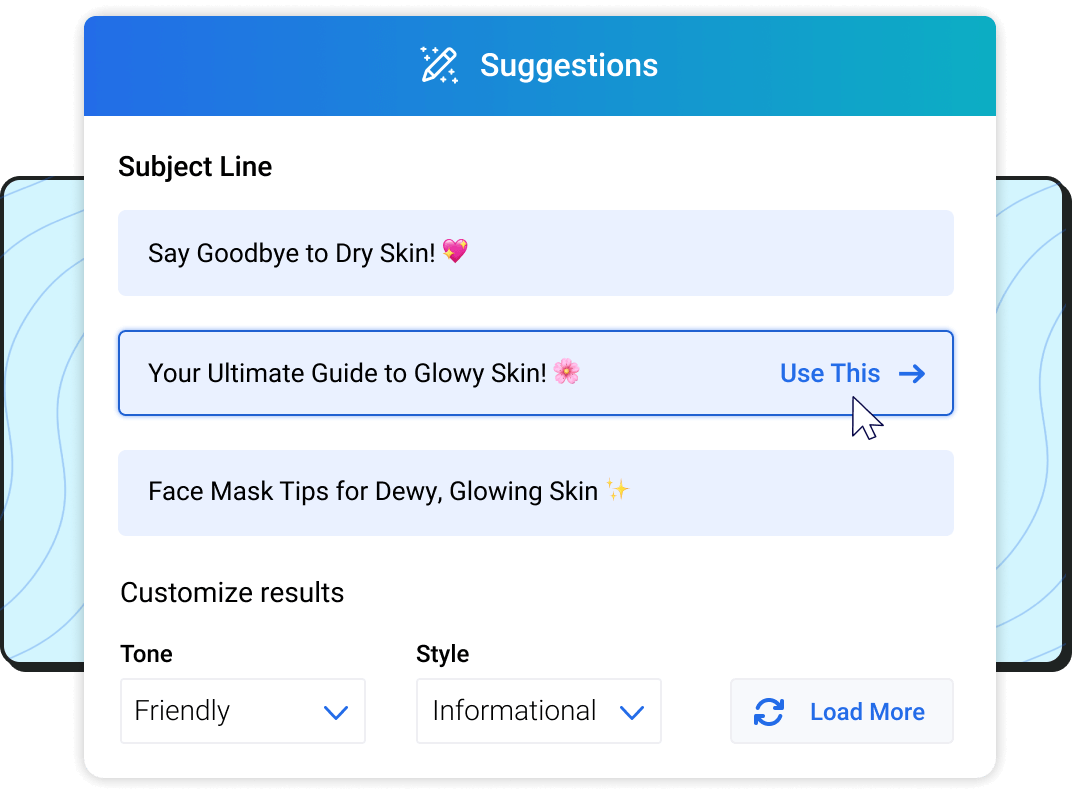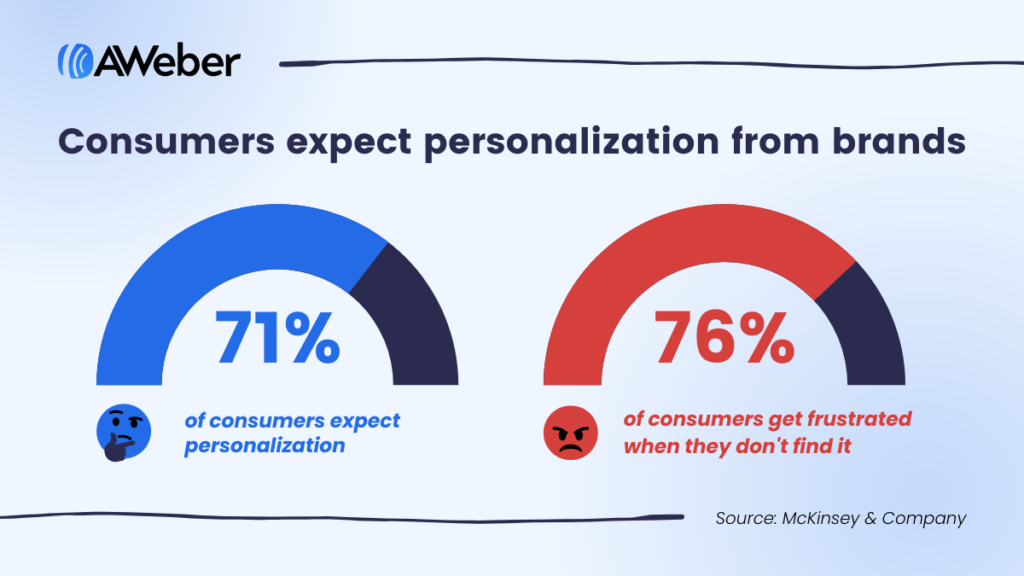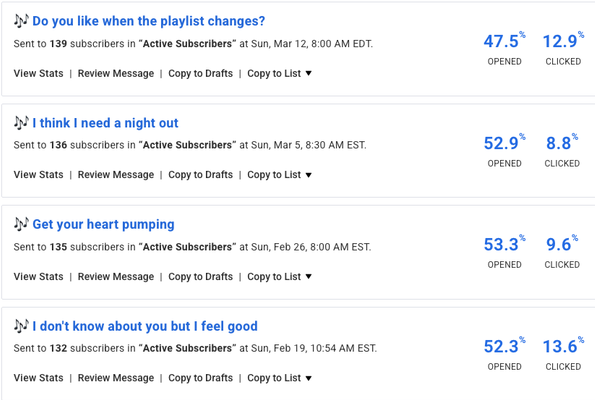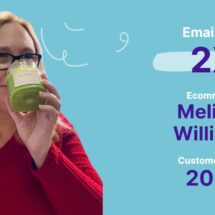9 ways artificial intelligence can improve your email marketing
By Kaleigh Moore April 27, 2023
It’s hard to talk about modern marketing without mentioning artificial intelligence (AI). According to Influencer Marketing Hub, 61.4% of marketers have used AI in their marketing activities. Moving forward, companies that want to stay ahead of the competition must keep a pulse on the latest AI developments.
One of the areas where we can witness various AI use cases is email marketing. And this is nothing new. However, technology advancements have slowly made AI an unavoidable part of every marketer’s email marketing strategy.
From the definition of AI in email marketing to what are the benefits of using AI, and how you can use AI to improve your email marketing results—we’ll answer these questions and more. Here’s everything you need to know to use the power of AI and step up your email marketing campaigns. Let’s dive in.
How is AI used in email marketing?
Artificial intelligence in email marketing is the use of AI technology to draft, personalize, automate, test, analyze, and optimize email campaigns.
According to Statista, 32% of marketers are using artificial intelligence (AI) and marketing automation to personalize email messages and offers. AI is combined with marketing automation by 22% of marketers when it comes to product and content recommendations, as well as the personalization of email subject lines.
However, this is just the tip of the iceberg. Before diving into all the different use cases for AI in email marketing, let’s first look at the benefits.
What are the benefits of AI in email marketing?
The benefits of incorporating AI as part of your email marketing strategy are no longer just a theoretical statement—they are evidence-based. So instead of adopting AI in email marketing just because others are doing it, you have to understand its benefits and measure results against industry benchmarks.
Here are some of the essential benefits of AI in email marketing (Data from Statista):
- Boost revenue – The use of AI has a positive impact on companies’ bottom line. Marketers using AI for email personalization said their revenue increased by 41%.
- Save time – Businesses are always struggling to save more time and resources. Here is where AI comes in handy. For 33% of marketing professionals using artificial intelligence and machine learning (ML) tools in their marketing programs, the leading benefit was the time saved.
- Understand customer preferences and behavior – The only way to fuel your business and improve results is to understand customers’ wants and needs. 31% of professionals working with AI and ML stated that the same tools benefited their trend insights, audience preference, or behaviors.
- Optimize content – Marketers are under constant pressure to create more content. The use of AI can help them in this endeavor. Data shows that 26% of American marketing professionals shared that AI and ML helped them improve or optimize content.
9 ways to use AI in your email marketing campaigns
Email marketing is one of the most important tools in every marketer’s toolbox. As a result, businesses face the challenge of competing for customers’ attention. The good news is that artificial intelligence can help you stand out in a crowded inbox. Here’s how.
1. Create better subject lines
Your email subject line can determine the success of your email campaign. It’s the first thing customers see when they receive your email, so no matter how good the offer is inside, if the subject line is not attention-grabbing, your email will be stuck with thousands of other unread emails in your customer’s inbox.
If you are constantly struggling with creating compelling subject lines, AI can help. For example, AWeber’s email builder can generate subject line option based on the content of your email. The feature even allows your to customize your results by tone and even the type of email your sending.

How to use it:
Generate different subject lines for your email campaigns and test to see what works best. Based on the email open rates, you can measure results and spot the patterns that will help you create email subject lines that get clicked.
2. Refine your email lists
Staying on top of your email database is a full-time job. The process of manual email database cleaning can be cumbersome. And it can be especially challenging for smaller teams or businesses with huge email databases.
With AI-powered technology, you can remove out-of-date contacts and automatically update personal information such as phone numbers, job titles, and other subscribers’ details. This will ensure your email lists are healthy and improve email deliverability.
How to use it:
Use an AI email validation tool to help subscribers submit their correct information the moment they subscribe by eliminating typos and notifying them about invalid email addresses. Beyond this, thanks to real-time API scans, you can detect and prevent invalid email addresses before launching your campaign, which leads to a lower bounce rate and better deliverability.
3. Craft highly personalized emails
It’s no surprise unpersonalized emails have low engagement rates—no one wants to feel like a number in a CRM system. According to McKinsey, 71% of consumers expect companies to deliver personalized interactions. However, personalization at scale can be daunting without the right tools.

Today, thanks to advances in technology, businesses can rely on AI email assistants such as Lavender to create personalized email outreach. Companies can use this type of tool to see social media updates, funding announcements, and company information based on the prospect’s email address. Using these insights, sellers write emails in half the time and get twice as many replies.
How to use it:
Personalize your email outreach messages to improve your response rate. If the person you’re contacting has recently been promoted, congratulate them. If the company received an award, include that in the email. If you want to build a solid relationship and provoke action, you have to personalize your outreach.
4. Discover new segments based on customer behavior
Studies show that sending personalized content can result in 6x higher conversion rates. Email segmentation enables you to deliver targeted content that resonates with your audience. But what if you can go beyond the basic segments based on demographic information? And no, you don’t need a crystal ball for it.
With AI, you can use purchase history, customer behavior, and preferences to segment your email lists and deliver personalized emails. This takes the guesswork out of your email marketing efforts.
How to use it:
Handling hundreds of different newsletters is impossible without artificial intelligence. What seemed like a nightmare just a couple of years ago now becomes easier than ever. You can use AI to create a smart newsletter with personalized content based on your subscriber’s interests and boost engagement.
5. Send your emails at the right time
Another hurdle email marketers often face is sending their emails at the right time. While there are some guidelines on the best days and times for sending your emails, to maximize the results and get more opens and clicks, you want to optimize sending time on an individual level.
Using AI, you can analyze email recipients’ activity history, and based on their behavior, you can determine the best time to send your email marketing campaigns.
How to use it:
Rely on AI-powered tools to send email campaigns based on the subscriber’s location and time zone. This way, you avoid the risk of ending up in the trash before even a single click.
6. Generate various email ideas
Marketers are faced with the pressure to create many different email promotions, newsletters, and offers on a weekly basis. This can often lead to a creative rut—the state of being blank out of creative ideas.
But instead of looking at an empty screen, you can turn to AI to generate some ideas and spark your creativity. Alycia McFarlin, Zumba instructor, and AWeber team member, struggled to create a regular newsletter because she was afraid she couldn’t give the readers anything interesting to read. So she decided to ask ChatGPT (an AI-powered writing tool) to give her topic ideas by adding a simple prompt—“What can I write about in a Zumba newsletter?”

As soon as she put those ideas into action, she noticed a huge spike in the average click rate from 1.9% to 11.2%—almost a 500% improvement.
How to use it:
When brainstorming ideas for your next email campaign, turn to AI to generate different topics and copy proposals. Don’t rely fully on AI—analyze the proposals you get, improve, test, and iterate.
7. Improve customer experience based on the lifecycle stage
Sending an engaging email marketing campaign requires context. And you can’t get context without understanding the customer lifecycle. Based on the stage in the journey, customers act differently and have different expectations.
Using AI and predictive analytics, you can generate insights that allow you to comprehend customers’ lifecycle stages and send contextual campaigns to maximize your email marketing efforts.
How to use it:
Customers that have bought 50 times from your e-commerce store won’t act the same as first-time buyers. While this seems like a no-brainer personalizing your email campaigns based on lifecycle stage manually is a Sisyphean task. With AI and predictive analytics, you can tailor campaigns based on expected behavior to maximize results.
8. Build retargeting campaigns with personalized product recommendations
Not everyone that visits your website will end up making a purchase. Your job is to build retargeting campaigns and pave the way to the “add to cart” button. But you won’t be able to do that with random, generic product recommendations. Here’s where AI comes into the picture.
AI technology allows businesses to track on-site activity and include personalized product recommendations in email campaigns. Equipped with these insights, email marketers can create well-performing browse and cart abandonment emails.
How to use it:
In some cases, customers need a slight nudge to make the final decision. Use AI-powered technology to create cart abandonment emails with the exact products customers left in their cart to boost sales.
9. Run automated multivariate tests
If you are A/B testing different subject lines for your email campaigns, you are just scratching the surface. AI allows you to perform multivariate tests and compare a higher number of variables to reveal more information.
So instead of just testing subject lines, you can add additional variables such as email body, offers, design elements, and even calls to action. Based on the performance, you’ll be able to see which variation is most effective.
How to use it:
AI technology allows you to find the most effective version of the email campaign based on the results from a smaller batch of your email list. This way, you can test different subject lines, call-to-action buttons, visuals, or offers, and based on the initial results, AI will determine the final version of the campaign that will be sent to the rest of your list.
Ready to create your next email campaign?
The next chapter of AI-powered email marketing is here. Staying ahead of the wave will require unique insights, testing, analyzing, and optimizing your email marketing campaigns. Email marketing is still one of the most powerful tools for reaching your audience, and thanks to AI, it will stay that way.
It’s never been a better time to transform your business with the power of email marketing. Get started with AWeber today—it’s free!
 87% off ends soon!
87% off ends soon! 
